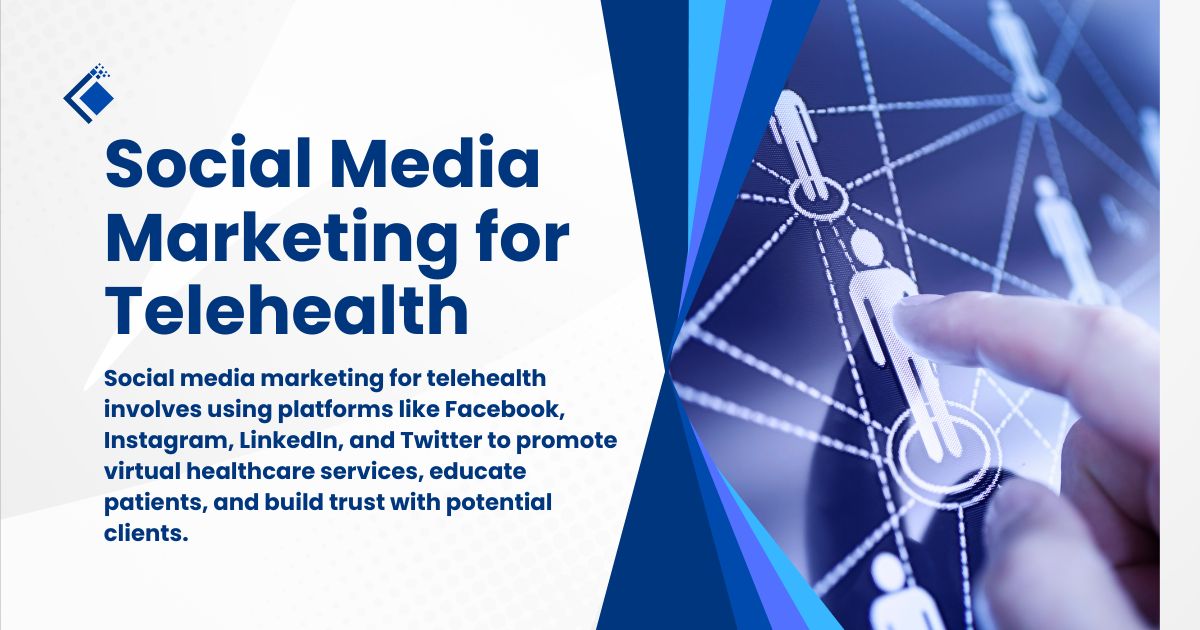
The healthcare landscape has transformed dramatically over the past decade, with telehealth services becoming a cornerstone of modern medical practice. As patients increasingly seek convenient, accessible healthcare options, medical professionals are turning to social media marketing to reach and engage their target audiences. However, marketing telehealth services requires a delicate balance between promotional effectiveness and strict healthcare regulations.
Social media marketing for telehealth involves using platforms like Facebook, Instagram, LinkedIn, and Twitter to promote virtual healthcare services, educate patients, and build trust with potential clients. Unlike traditional healthcare marketing, telehealth social media strategies must address unique challenges such as establishing credibility in a digital environment, complying with HIPAA regulations, and overcoming patient hesitations about virtual care.
This comprehensive guide will explore the essential strategies, best practices, and regulatory considerations for successfully marketing telehealth services through social media channels. Whether you’re a healthcare provider launching your first virtual practice or an established medical professional expanding into digital services, understanding these principles will help you connect with patients while maintaining professional standards and legal compliance.
Understanding the Telehealth Social Media Landscape
The intersection of healthcare and social media creates unique opportunities and challenges that don’t exist in other industries. Telehealth providers must navigate complex regulatory environments while building meaningful connections with patients who may be skeptical about receiving medical care through digital channels.
Why Social Media Matters for Telehealth
Patients researching healthcare options frequently turn to social media platforms for information, reviews, and recommendations. A strong social media presence helps telehealth providers establish credibility, demonstrate expertise, and humanize their virtual services. This digital visibility becomes particularly crucial for telehealth practices that lack physical storefronts where patients can walk in and meet providers face-to-face.
Social media also serves as an educational platform where healthcare providers can address common misconceptions about telehealth services. Many patients still harbor concerns about the effectiveness of virtual consultations, data security, and the quality of care they’ll receive. Strategic social media content can address these concerns proactively, building confidence in your services before patients even schedule appointments.
Platform-Specific Considerations
Different social media platforms serve distinct purposes in telehealth marketing strategies. LinkedIn works exceptionally well for B2B healthcare marketing, connecting with other medical professionals, and establishing thought leadership in the telehealth space. Facebook and Instagram excel at patient education and community building, while Twitter proves valuable for sharing quick health tips and participating in healthcare conversations.
Each platform also has different demographic profiles that influence your content strategy. Facebook users tend to be older and may require more education about telehealth benefits, while Instagram’s younger audience might be more comfortable with digital healthcare but need information about insurance coverage and service availability.
Building Trust Through Authentic Content

Trust forms the foundation of all healthcare relationships, and this principle becomes even more critical SEO in telehealth marketing. Patients considering virtual healthcare services often worry about receiving impersonal or inadequate care. Your social media content marketing address these concerns by demonstrating the human side of your practice and the quality of care patients can expect.
Showcasing Provider Expertise
Share content that highlights your medical credentials, specializations, and experience with telehealth platforms. This might include posts about continuing education, conference attendance, or certifications in telemedicine. However, avoid overwhelming followers with credentials alone. Instead, blend professional achievements with practical health insights that demonstrate your expertise in action.
Patient testimonials and success stories provide powerful social proof, but they require careful handling to maintain HIPAA compliance. Consider featuring general testimonials about the telehealth experience rather than specific medical outcomes, or work with patients who provide explicit written consent for sharing their stories.
Creating Educational Content
Educational content serves dual purposes in telehealth marketing: it provides value to your audience while positioning you as a knowledgeable healthcare provider. Focus on topics that align with your specialties and address common patient questions about virtual care.
Develop content series that explain how telehealth consultations work, what technology patients need, and how to prepare for virtual appointments. Address practical concerns like insurance coverage, prescription fulfillment, and follow-up care coordination. This type of content reduces barriers to care by helping patients understand what to expect from telehealth services.
Navigating HIPAA Compliance in Social Media
Healthcare providers must maintain strict compliance with HIPAA regulations when using social media for marketing purposes. This requirement creates unique challenges that don’t exist in other industries and requires careful planning of all social media activities.
Protected Health Information Guidelines
Never share specific patient information, medical records, or identifiable health details on social media platforms. This restriction extends beyond obvious identifiers like names and photos to include any combination of information that could potentially identify a patient. Even seemingly harmless details like appointment times, specific symptoms, or treatment outcomes can violate HIPAA requirements if combined with other publicly available information.
When discussing patient cases for educational purposes, use completely hypothetical examples or obtain explicit written authorization from patients. Many healthcare providers find it safer to focus on general health education rather than case studies that might inadvertently reveal protected information.
Secure Communication Practices
Social media platforms should never be used for actual patient communication or appointment scheduling unless they meet HIPAA-compliant standards. Direct patients to secure portals, encrypted messaging systems, or phone lines for any medical discussions. Include clear disclaimers on your social media profiles stating that the platforms are for educational purposes only and not for medical emergencies or patient communication.
Consider implementing social media policies for your entire healthcare team to ensure consistent compliance across all staff members who might interact with your practice’s social media accounts.
Content Strategy for Telehealth Providers

Successful telehealth social media marketing requires a well-planned content strategy that balances educational value, promotional messaging, and community engagement. Your content should address the unique aspects of virtual healthcare while maintaining the professional standards expected in medical communications.
Health Education and Prevention
Share evidence-based health information that aligns with your medical specialties. This content establishes your expertise while providing genuine value to followers. Focus on preventive care topics, healthy lifestyle tips, and explanations of common medical conditions that don’t require specific patient examples.
Seasonal health content performs particularly well on social media. Share information about flu prevention during fall months, sun safety tips in summer, or mental health awareness during relevant awareness months. This type of content demonstrates your ongoing commitment to patient wellbeing beyond individual consultations.
Telehealth-Specific Education
Many potential patients still have questions and concerns about telehealth services. Create content that specifically addresses these concerns and educates your audience about the benefits and limitations of virtual care. Explain which types of appointments work well via telehealth and which situations require in-person visits.
Share behind-the-scenes content showing your telehealth setup, technology platforms, and preparation processes. This transparency helps patients understand the professional standards you maintain for virtual consultations and can reduce anxiety about the quality of care they’ll receive.
Technology and Accessibility Tips
Help patients prepare for successful telehealth appointments by sharing technology tips and troubleshooting guides. Create simple infographics explaining how to test camera and microphone settings, optimize internet connections, or download necessary applications.
Address accessibility concerns by sharing information about how patients with disabilities can access telehealth services, what accommodations are available, and how to request additional support when needed.
Engagement Strategies That Work
Social media engagement goes beyond posting content; it involves building genuine relationships with your audience and creating communities around healthcare topics. For telehealth providers, engagement strategies must balance accessibility with professional boundaries.
Community Building
Foster online communities where patients can connect over shared health interests or conditions. This might involve creating Facebook groups focused on specific health topics, hosting Instagram Live sessions for Q&A discussions, or participating in Twitter chats about healthcare trends.
Always moderate these communities carefully to prevent the spread of medical misinformation and ensure discussions remain appropriate. Establish clear community guidelines that prohibit sharing specific medical advice, personal health information, or promotional content from other healthcare providers.
Responding to Comments and Messages
Develop clear protocols for responding to social media comments and direct messages. While you want to be responsive and helpful, you must avoid providing specific medical advice through social media platforms. Create standard responses that acknowledge questions while directing people to appropriate channels for medical consultations.
Train your staff on appropriate social media responses and consider designating specific team members to handle social media interactions. This ensures consistency in your messaging and reduces the risk of HIPAA violations or inappropriate medical advice.
Measuring Success and ROI

Tracking the effectiveness of your telehealth social media marketing efforts requires specific metrics that align with healthcare marketing goals. Unlike e-commerce businesses that can directly track sales from social media, healthcare providers must focus on awareness, engagement, and patient acquisition metrics.
Key Performance Indicators
Monitor engagement rates, follower growth, and content reach to understand how well your messages resonate with your audience. Track website traffic from social media platforms, particularly visits to pages about your telehealth services, appointment scheduling systems, and educational resources.
Patient acquisition metrics provide the most direct measure of social media marketing success. Track how many new patients mention finding your practice through social media, and monitor appointment booking patterns to identify correlations with your social media activities.
Long-term Relationship Building
Remember that healthcare marketing often involves longer decision-making processes than other industries. Patients may follow your social media accounts for months before scheduling their first appointment. Focus on building long-term relationships rather than expecting immediate conversions from your social media efforts.
Survey new patients about their decision-making process and what factors influenced their choice to use your telehealth services. This feedback helps you understand which types of content and messaging strategies prove most effective for patient acquisition.
Staying Compliant While Building Your Practice
Social media marketing for telehealth requires ongoing attention to regulatory compliance, platform changes, and evolving patient expectations. Success comes from balancing promotional goals with educational value while maintaining the highest standards of professional conduct.
Regular training on HIPAA requirements, social media best practices, and telehealth regulations ensures your marketing efforts remain compliant as rules and platforms evolve. Consider working with healthcare marketing professionals who understand the unique challenges of promoting medical services through social media channels.
Your social media presence should reflect the same professionalism and care standards that patients experience during telehealth consultations. By focusing on education, transparency, and genuine patient care, you can build a strong social media presence that attracts new patients while supporting your existing community’s health and wellness goals.
The future of healthcare increasingly involves digital connections and virtual care delivery. Healthcare providers who master social media marketing for telehealth services will be better positioned to serve patients in this evolving landscape while building sustainable, compliant practices that thrive in the digital age.















No Comments